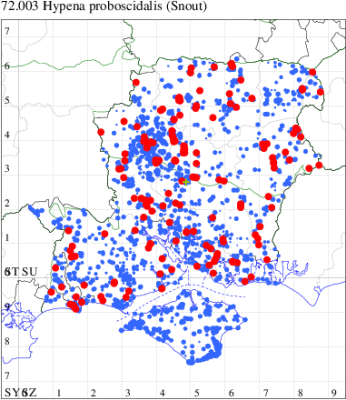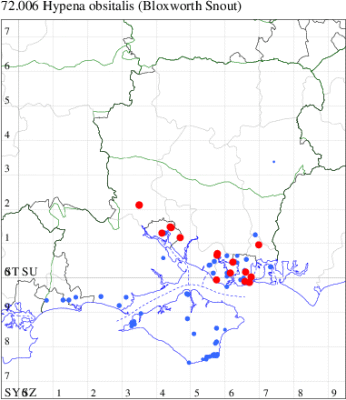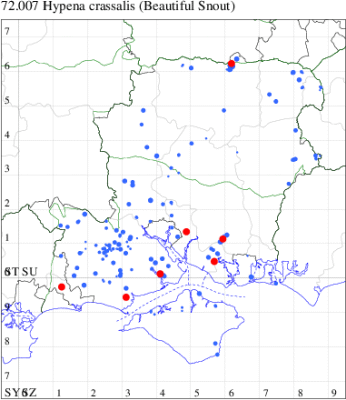2023 Annual Report for: Erebidae / Hypeninae
For species seen in 2023 that had less than or equal to 100 records, full details are included; for more common species, the earliest, latest and highest count by vice-county are shown. The narrative for each species is taken from the main Hantsmoths website, and it is possible that some information on abundance and occurrence can get out of date, as it is impossible to keep up with all changes; however it should give a good introduction to each species. The tables in each species account summarise the previous status, and that for the current year.
For the maps, all records prior to 2023 are shown by a blue dot (the larger the dot, the more recent), with the current year's records shown in red. As previous records are superimposed on any report for 2023, new sites have greater emphasis (i.e. will show as 'more red').
In the species accounts, an asterisk next to a location indicates a new 10km square record; earliest ever dates are highlighted in orange, and latest ever in red. Initials in the species accounts refer to the recorders listed here. Please get in touch if you identify any omissions or errors, in particular if you have records that have yet to be submitted. Details of how to submit records can be found here.
72.003 [B&F: 2477] Snout Hypena proboscidalis (Linnaeus, 1758) - Common
Common in a wide range of habitats, including woodland, scrub, hedgerows, gardens, rough meadows and marshes throughout the British Isles. Widespread and common in Hampshire and on the Isle of Wight. Wingspan 34-40 mm. The combination of clear brown fascia and long, upturned palps make this a fairly unmistakable species, but occasionally individuals may lose their snout, or are mottled and have no cross-lines. Larva feeds on Stinging Nettle.
Records prior to 2023
| Vice County | #Records | #Individuals | First Record | Last Record |
|---|---|---|---|---|
| 10 | 1685 | 4485 | 1951 | 2022 |
| 11 | 12430 | 20450 | 1951 | 2022 |
| 12 | 4530 | 9436 | 1951 | 2022 |
2023 records
| Vice County | #Records | #Individuals | Max Quantity |
|---|---|---|---|
| 11 | 451 | 785 | 13 |
| 12 | 243 | 658 | 35 |

Records by year
Records by week (adult)
Records by week (larval)
Record Summary
VC11: Earliest: Muscliffe, 24 May, 1 (KingB) Latest: Botley, 19 Nov, 1 (SLB) Max count: Hurn, 12 Sep, 13 (MJef)
VC12: Earliest: Whitehill, 04 Jun, 1 (ASto) Latest: Farnham, 12 Oct, 0 (Bird) Max count: Pamber Forest, 06 Sep, 35 (GJD)
72.004 [B&F: 2480] Buttoned Snout Hypena rostralis (Linnaeus, 1758) - Nb
Nationally scarce (Nb) in hedgerows, woodland edges and gardens throughout much of south-eastern England, and a priority species under the UK Biodiversity Action Plan. In Hampshire and on the Isle of Wight very local, but since 1990 there does appear to have been an increase in the numbers reported, with a peak of 44 records in 2001. Wingspan 29-32 mm. The main confusion species is Bloxworth Snout H. obsitalis, which has the forewing more pointed and broader, with a conspicuous white patch below the costa outside the median fascia, followed by horizontal dashes (MBGBI Vol 10). Larva feeds on Hop.
Records prior to 2023
| Vice County | #Records | #Individuals | First Record | Last Record |
|---|---|---|---|---|
| 10 | 105 | 69 | 1800 | 2022 |
| 11 | 356 | 375 | 1800 | 2022 |
| 12 | 118 | 117 | 1800 | 2022 |
2023 records
| Vice County | #Records | #Individuals | Max Quantity |
|---|---|---|---|
| 11 | 13 | 14 | 2 |
| 12 | 4 | 4 | 1 |

Records by year
Records by week (adult)
Records by week (larval)
Record Details
VC11: Fordingbridge, one, indoors, 20 Sep (SCT); Totton, one, 07 Jun (CNB); Romsey, one, 24 May (MJB); Dibden Purlieu, NF, one, 09 Jun (RAC); Swaythling, Southampton, two, 10 Jun; one, 12 Jun (MEdg); Chandler's Ford, one, 10 Jun (KArb); Stubbington, one, 10 Jun (DPH); Fareham, one, 11 Jun; one, 10 Aug (KJW); Portchester, one, 03 Nov (CEH, JGS); Muscliffe, one, 07 Jun (KingB); Hurn, one, field observation, in wood store outside. , 01 Feb (MJef);
VC12: Noar Hill HIWWT NR, Selborne, one, 09 Jun (AMD, FHay det. AMD); Whitehill, one, 28 Apr (ASto); Farnborough, one, 24 May; one, 11 Jun (KBW)
72.006 [B&F: 2478] Bloxworth Snout Hypena obsitalis (Hübner, [1813]) - Nationally Scarce
A rare Red Data Book species, on sea cliffs, grassy slopes and undercliffs in parts of south-western England. First recorded at Bloxworth, Dorset, in September 1884, remaining a very scarce migrant until 1990, when a small population was discovered at Torbay, Devon. The species soon colonised the south coast from the Lizard in Cornwall to Purbeck in Dorset. On the Isle of Wight, since 2003, increasingly recorded hibernating in small numbers in outhouses and caves, and at light, and is undoubtedly now established on the south-east coast of the Island. In Hampshire recorded in the mid-1990s in both vice-counties, and again in 2009 at Southsea; since this time it has dramatically increased in status in the Portsmouth area: there were 23 records in 2013 and 29 in 2014. Wingspan 29-32 mm. Larva feeds on Pellitory-of-the-wall.
Records prior to 2023
| Vice County | #Records | #Individuals | First Record | Last Record |
|---|---|---|---|---|
| 10 | 138 | 143 | 1968 | 2022 |
| 11 | 299 | 436 | 1995 | 2022 |
| 12 | 1 | 1 | 1994 | 1994 |
2023 records
| Vice County | #Records | #Individuals | Max Quantity |
|---|---|---|---|
| 11 | 29 | 31 | 5 |

Records by year
Records by week (adult)
Records by week (larval)
Record Details
VC11: Romsey, present, 05 Oct; one, indoors, 05 Oct (SRC); Southampton, present, field observation, 31 Oct (IKha); Peartree Green LNR, Southampton, one, 23 Sep (MGP); Bitterne, Southampton, one, field observation, 16 Sep (GFra det. PAB); Thornhill, Southampton, one, field observation, 22 Nov (PAB); Fareham, one, 06 Sep (MLO); one, 11 Feb; one, 04 May; one, 31 Aug; one, field observation, 01 Sep; one, 23 Oct; one, 03 Dec (KJW); Gosport, one, 21 May (KIls); Portchester, one, 05 Sep (DH-J); Portsea Island, Southsea, one, field observation, 26 Jan (Unkn. det. MJW); Portsmouth, one, 23 Jun; one, 28 Jun (IRT); Waterlooville, one, 03 Nov (DWhe); Browndown Coastal Ranges, one, 05 May (F.M.G.); Southsea, one, 05 Jan; one, 02 Mar; one, 10 May; one, 25 Jun; one, 09 Sep; one, 12 Sep; one, 23 Sep; one, 09 Oct (JGdr); Eastney, five, field observation, 29 Mar (TDC)
72.007 [B&F: 2476] Beautiful Snout Hypena crassalis (Fabricius, 1787) - Local
Local in open woodland, moorland and heathland throughout England and Wales, but less commonly in the north. In Hampshire locally common in the New Forest and Pamber Forest, with occasional records elsewhere in the county and on the Isle of Wight. Wingspan 33-35 mm. Unmistakable. Larva feeds on Bilberry, over-wintering as a pupa.
Records prior to 2023
| Vice County | #Records | #Individuals | First Record | Last Record |
|---|---|---|---|---|
| 10 | 16 | 10 | 1981 | 2022 |
| 11 | 312 | 259 | 1951 | 2022 |
| 12 | 76 | 121 | 1951 | 2021 |
2023 records
| Vice County | #Records | #Individuals | Max Quantity |
|---|---|---|---|
| 11 | 8 | 8 | 1 |
| 12 | 2 | 2 | 1 |

Records by year
Records by week (adult)
Records by week (larval)
Record Details
VC11: Needs Ore NNR, one, 02 Jul; one, 23 Jul (CNB); Fareham, one, 15 Jun (ADT); Wickham, one, 12 Jun; one, 22 Jun; one, 07 Jul (JRDS); Hurn, one, 19 Jun (MJef); Pennington, one, 05 Sep (RFC);
VC12: Grayshott, one, 07 Jul (THard); Silchester Common, one, 07 Jul (WLan)